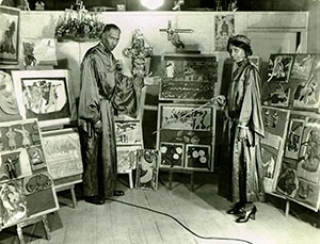Born 1892, Baldwyn, Mississippi
Died 1984, Columbus, Ohio
Elijah Pierce was the second-youngest child of a former slave. He led a transient life at first that included working as a barber’s assistant in Baldwyn, then traveling as a laborer throughout the Mississippi River Valley after the death of his wife and eventually obtaining his license as a Baptist preacher. In 1923 Pierce remarried and settled with his second wife in Columbus, Ohio, where his many endeavors coalesced. He opened a barbershop, which included a separate studio space for his sculptural practice. Many of his three-dimensional works focused on biblical narratives, and he viewed these as an extension of his ministry.
Pierce’s Crucifixion, from the mid-1930s, condenses the story of Christ’s death in a moving tableau. The artist affixed sculpted figures to a wooden background so that the narrative proceeds upward from the bottom. Old Testament prophets march along the base of the frame, while above them a devil surrounded by Roman soldiers holds a lance and a pitchfork. From the upper third, Christ looks down at the chaos, while a small anthropomorphized moon above the cross has a single blood-saturated teardrop staining its cheek. Through Pierce’s dynamic figures, the pathos of the scene is palpable.
More indicative of his later style, Pearl Harbor and the African Queen serves a pedagogical function, although its composition pits seemingly transparent images against a complex iconography. In four quadrants Pierce presents a series of discordant images: Franklin D. Roosevelt in front of an abstracted American flag, a black “Uncle Sam” witnessing the attack on Pearl Harbor, a dog with the word DUTY overhead, and a mirrored image of the eponymous “African Queen,” potentially a reference to C. S. Forester’s book of the same name. It is an image informed by warfare, as it indexes World War I, World War II, US patriotism, and black involvement within the wars, yet it remains ambiguous and not at all pedantic. In 1982, following his inclusion in Black Folk Art in America, 1930–1980 at the Corcoran Gallery of Art, he was awarded the National Heritage Fellowship from the National Endowment of the Arts.
Nicholas Miller
Harris, William E. “Elijah Pierce: More Than a Preacher of Wood.” The International Review of African American Art 11 (January 1, 1993): 36–39.
Jones, Carolyn. Elijah Pierce, Woodcarver. Columbus, OH: Columbus Gallery of Fine Arts, 1973.
Roberts, Norma J. Elijah Pierce, Woodcarver. Columbus, OH: Columbus Museum of Art, 1992.
